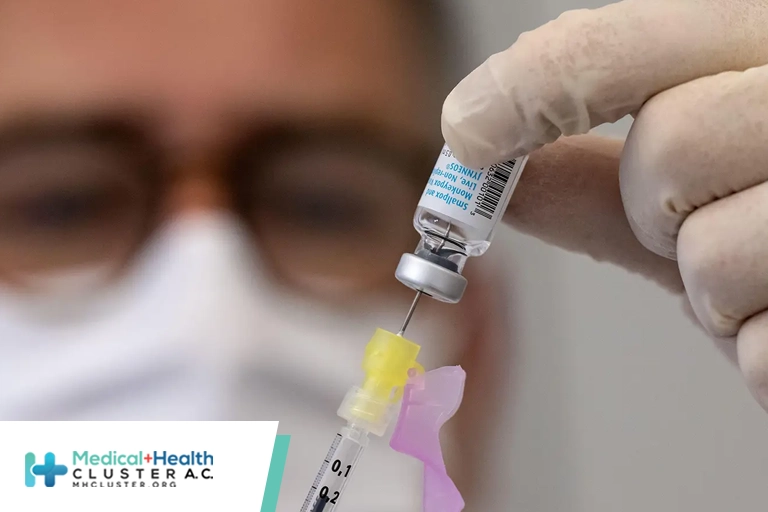CONDENA MH CLÚSTER ATAQUE ARMADO A HOSPITAL ARCÁNGELES
Leer más
Estimated Effectiveness of JYNNEOS Vaccine in Preventing Mpox: A Multijurisdictional Case-Control Study — United States, August 19, 2022–March 31, 2023

Summary
What is already known about this topic?
Real-world vaccine effectiveness (VE) estimates for JYNNEOS vaccine against monkeypox (mpox) are limited. To date, no VE estimates by route of administration or for immunocompromised persons have been published.
What is added by this report?
In this study, adjusted VE was 75% for 1 dose and 86% for 2 doses of JYNNEOS vaccine, indicating substantial protection against mpox, irrespective of route of administration or immunocompromise status.
What are the implications for public health practice?
Persons at high risk for mpox exposure should be vaccinated with the recommended 2-dose JYNNEOS series.
As of March 31, 2023, more than 30,000 monkeypox (mpox) cases had been reported in the United States in an outbreak that has disproportionately affected gay, bisexual, and other men who have sex with men (MSM) and transgender persons (1). JYNNEOS vaccine (Modified Vaccinia Ankara vaccine, Bavarian Nordic) was approved by the Food and Drug Administration (FDA) in 2019 for the prevention of smallpox and mpox via subcutaneous injection as a 2-dose series (0.5 mL per dose, administered 4 weeks apart) (2). To expand vaccine access, an Emergency Use Authorization was issued by FDA on August 9, 2022, for dose-sparing intradermal injection of JYNNEOS as a 2-dose series (0.1 mL per dose, administered 4 weeks apart) (3). Vaccination was available to persons with known or presumed exposure to a person with mpox (postexposure prophylaxis [PEP]), as well as persons at increased risk for mpox or who might benefit from vaccination (preexposure mpox prophylaxis [PrEP]) (4). Because information on JYNNEOS vaccine effectiveness (VE) is limited, a matched case-control study was conducted in 12 U.S. jurisdictions,† including nine Emerging Infections Program sites and three Epidemiology and Laboratory Capacity sites,§ to evaluate VE against mpox among MSM and transgender adults aged 18–49 years. During August 19, 2022–March 31, 2023, a total of 309 case-patients were matched to 608 control patients. Adjusted VE was 75.2% (95% CI = 61.2% to 84.2%) for partial vaccination (1 dose) and 85.9% (95% CI = 73.8% to 92.4%) for full vaccination (2 doses). Adjusted VE for full vaccination by subcutaneous, intradermal, and heterologous routes of administration was 88.9% (95% CI = 56.0% to 97.2%), 80.3% (95% CI = 22.9% to 95.0%), and 86.9% (95% CI = 69.1% to 94.5%), respectively. Adjusted VE for full vaccination among immunocompromised participants was 70.2% (95% CI = −37.9% to 93.6%) and among immunocompetent participants was 87.8% (95% CI = 57.5% to 96.5%). JYNNEOS is effective at reducing the risk for mpox. Because duration of protection of 1 versus 2 doses remains unknown, persons at increased risk for mpox exposure should receive the 2-dose series as recommended by the Advisory Committee on Immunization Practices (ACIP),¶ regardless of administration route or immunocompromise status.
A matched case-control study was conducted in 12 U.S. jurisdictions. Case-patients had a confirmed or probable Monkeypox virus or Orthopoxvirus diagnosis on or after August 19, 2022; they were identified or verified through jurisdiction health departments’ case registries. Control patients had visited a sexual health, HIV care, or HIV PrEP clinic on or after August 19, 2022, and did not receive an mpox diagnosis; they were identified through active and passive recruitment approaches at local clinics in each jurisdiction.** Participation was restricted to sexually active†† persons aged 18–49 years who self-identified as MSM or transgender. Eligible participants were invited to complete a survey administered online or by telephone in English or Spanish. The survey included questions about demographic characteristics, mpox vaccination, mpox diagnosis, immunocompromising conditions, and exposure history anchored to an index date, defined as date of positive test result (case-patients) or clinic visit (control patients). Survey responses were recorded in REDCap (version 13.1.26; Vanderbilt University). Participants’ vaccination status was verified using state vaccination registries, where available. Participants were categorized as fully vaccinated, partially vaccinated, or unvaccinated based on the number of JYNNEOS doses they received relative to their index date.§§
Each case-patient was matched with up to four control patients based on state or region¶¶ and index date (within 4 weeks). Conditional logistic regression models were used to estimate crude and adjusted odds ratios evaluating the association between vaccination status and case- or control patient status. The adjusted model accounted for covariates identified a priori, including age, race and ethnicity, immunocompromising conditions,*** and close contact with a person with known mpox.††† VE was calculated as (1 – odds ratio) x 100%. VE estimates were stratified a priori by immunocompromise status and route of vaccine administration (subcutaneous, intradermal, or heterologous [i.e., a different route for each dose]). Analyses were conducted using the survival package in R statistical software (version 4.2.2; The R Foundation). This activity was reviewed by CDC and was conducted consistent with applicable federal law and CDC policy.§§§
Among 1,414 respondents, 1,127 (86.1%) met the minimum data element requirements¶¶¶ for inclusion in the analysis, and 309 (89.6%) of 345 case-patients and 608 (77.7%) of 782 control patients were matched. A larger proportion of case- than control patients identified as non-Hispanic Black or African American (27.2% versus 16.9%) or Hispanic or Latino (32.4% versus 23.4%) (Table 1). Larger proportions of case- than control patients reported experiencing recent homelessness (7.9% versus 2.7%), engaging in transactional sex (9.1% versus 3.3%), and living with HIV (48.1% versus 24.0%); among participants who did not report living with HIV, a smaller proportion of case- than control patients reported using HIV PrEP (54.4% versus 66.8%). Larger proportions of case- than control patients were classified as immunocompromised (46.6% versus 26.0%) and reported recent close contact with a known mpox case (23.0% versus 3.9%).
Among the 917 participants included in the VE analysis, 206 (22.5%) were fully vaccinated, 295 (32.2%) were partially vaccinated, and 416 (45.4%) were unvaccinated. Unadjusted VE was 75.7% for partial vaccination and 87.4% for full vaccination (Table 2). After adjusting for age, race and ethnicity, immunocompromise status, and close contact with a person with known mpox, VE was 75.2% for partial vaccination and 85.9% for full vaccination. Among partially vaccinated participants, adjusted VE by route of administration was 77.0% for subcutaneous and 80.6% for intradermal administration. Among fully vaccinated participants, adjusted VE was 88.9% for subcutaneous, 80.3% for intradermal, and 86.9% for heterologous administration. Among participants with an immunocompromising condition, adjusted VE was 51.0% for partial vaccination and 70.2% for full vaccination, both with negative lower 95% CI bounds. Among participants without an immunocompromising condition, adjusted VE was 72.1% for partial vaccination and 87.8% for full vaccination.
Discussion
In this real-world assessment of JYNNEOS VE in 12 U.S. jurisdictions during the 2022 mpox outbreak, adjusted VE against mpox was 75.2% for partial vaccination and 85.9% for full vaccination. The results from this study are consistent with those from previous studies evaluating vaccine performance or effectiveness (5–7) and strengthen the evidence base supporting vaccination with JYNNEOS for protection against mpox.
This study is the first to estimate VE by route of administration. Similar point estimates and overlapping CIs for estimates by route of administration suggest that, in the context of the current outbreak, vaccine administration by any route provides comparable protection against mpox.
This study also estimated VE for immunocompromised persons. Although the lower bounds of the 95% CIs for immunocompromised persons were negative (indicating the need for more data to obtain more precise estimates), adjusted VE estimates were 51.0% for partial vaccination and 70.2% for full vaccination among immunocompromised participants, and 72.1% for partial and 87.8% for full vaccination among immunocompetent participants. Overlapping CIs for these VE estimates suggest no difference by immunocompromise status, although the lower VE point estimates in participants who are immunocompromised might suggest a less robust response to the vaccine. Persons with immunocompromising conditions might mount a less effective immune response after vaccination**** and might choose to take additional precautions to reduce their risk for mpox infection, such as reducing their number of sex partners and one-time sexual encounters (8).
The findings in this report are subject to at least seven limitations. First, selection bias was likely present because participation was voluntary and recruitment for controls took place in sexual health, HIV care, or HIV PrEP clinics. Second, survey data were self-reported and might be subject to social desirability or recall bias, particularly because the time between index event and survey completion varied. Third, vaccination status could have been misclassified if participants were vaccinated outside of their jurisdiction or if a participant’s vaccination dates were incorrectly reported. Fourth, immunocompromise status was based on self-report; these persons might not be considered immunocompromised by clinical standards. In addition, because of limited data on HIV status, some participants with well-controlled HIV might have been incorrectly classified as immunocompromised. Fifth, some jurisdictions had challenges recruiting controls. As a result, 35 case-patients were not matched and were excluded from the analysis. Sixth, because of small sample sizes, VE for PEP could not be estimated. Finally, although the 12 U.S. jurisdictions included in this study covered a broad geographic area, data might not be generalizable to the entire U.S. population.
Vaccination is an important tool for preventing mpox,†††† and this report demonstrates that the JYNNEOS vaccine is effective at reducing risk for mpox; however, additional precautions to reduce exposure should be considered, particularly among immunocompromised persons (8). Both 1 and 2 doses provided substantial protection against mpox, irrespective of route of administration. However, additional research is needed to assess duration of protection, which might differ by number of doses or route of administration. JYNNEOS vaccination coverage among persons at risk is low, and many eligible persons have not received both doses (9–10). For optimal protection, persons at risk for mpox should receive the 2-dose series, as recommended by ACIP, irrespective of administration route.
Acknowledgments
Susan Fuller, Rainy Henry, Angelica O’Connor, Alvin Shultz, Jason Snow, CDC; Kimberly Gonzalez Barrera, Samuel Holland, California Department of Public Health; Ryan Buckman, Maria Rosales, California Emerging Infections Program; Jennifer House, Colorado Department of Health and Environment; Eric D. Anthony, Mary Frances De Rose, Sarah Gillani, DC Health; Jason Beverley, Division of STD and TB Control, DC Health; Nadine Oosmanally, Melissa Tobin-D’Angelo, Georgia Department of Public Health; Victoria Baldwin-Lawson, Nathaniel Elijah Barrera-Nitz, Sarah C. Busby, Rachael Gill, Erica Hazra, Maryam Heydari, Katherine A. Lee, Molly McAlvany, Taelor Moran, Emily Nelson, Bianca Perez, Gennesis Quinonez, Sofia Santoro, Paola Santos, Stepy Thomas, Emma Grace Turner, Georgia Emerging Infections Program; Hennepin County Public Health – Red Door Clinic; Sharon Balter, Chelsea Foo, Meredith Haddix, Andrea Kim, Moon Kim, Tae Hee Koo, Sonali Kulkarni, Olivia Moir, Kathleen Poortinga, Nava Yeganeh, Sherry Yin, Los Angeles County Department of Public Health; David Crum, Heather Rutz, Pat Ryan, Sophia Wozny, Maryland Department of Health; Marcie Babcock, Taylor Campbell, Beth Cleary, Paige D’Heilly, Andrew Frederick, Jayne Griffith, Cynthia Kenyon, Miriam Muscoplat, Ali Ruprecht, Minnesota Department of Health; Anthony M. Mills, Men’s Health Foundation; Meaghan Abrego, Bryon Backenson, Youjung Byun, Charlotte DelBarba, New York State Department of Health; Prachi Dahl, Kelly Jamison, Ciarra Leocadio, New York City Department of Health and Mental Hygiene; Josh Arevalo, Public Health Division, Multnomah Health Department; Greg Chambers, Jacqueline Logan, Tennessee Department of Health; Shealynn Hilliard, Jacob Scutaru, Trillium Health; Kristin E. Smith, University of Rochester Medical Center; Arthur L. Reingold, University of California, Berkeley; Pepper J. Heifner, Kristin Rager, Shertise Stogner, Del Ray Zimmerman, Vanderbilt Medical Center.
CDC Multijurisdictional Mpox Case Control Study Group
Kayla Saadeh, California Department of Public Health; Robert E. Snyder, California Department of Public Health; Madeline Anderson, California Emerging Infections Program; Vanessa Aryana Anguiano, California Emerging Infections Program; Joelle Nadle, California Emerging Infections Program; Gretchen Rothrock, California Emerging Infections Program; Sydney Jones, CDC Connecticut Department of Public Health; Lauren Duval, Colorado Department of Public Health and Environment; Rachel Herlihy, Colorado Department of Public Health and Environment; Ginger Stringer, Colorado Department of Public Health and Environment; Robyn Weber, Colorado Department of Public Health and Environment; Quyen Phan, Connecticut Department of Public Health; Lynn Sosa, Connecticut Department of Public Health; James Meek, Connecticut Emerging Infections Program Yale School of Public Health; Michelle Lee, DC Health; Allison S. Morrow, DC Health; Christina Willut, DC Health; Jesse Carlson, Denver Health; Kevin Kamis, Denver Health; Masayo Nishiyama, Denver Health; Gena Simien, Denver Health; Jonathan Colasanti, Emory University; Tamsin M. van der Woude, Georgia Emerging Infections Program; Roxanne Archer, Los Angeles County Department of Public Health; Lauren Finn, Los Angeles County Department of Public Health; Jane Lam, Los Angeles County Department of Public Health; Bret Moulton, Los Angeles County Department of Public Health; Erin Peterson, Los Angeles County Department of Public Health; Robert Bolan, Los Angeles LGBT Center; Gabriel Garcia-Lopez, Los Angeles LGBT Center; Kathryn Como-Sabetti, Minnesota Department of Health; Anna Ruff, Minnesota Department of Health; Dakota Schneider, Minnesota Department of Health; Tracy Robinson, Men’s Health Foundation; Bridget J. Anderson, New York State Department of Health; Kerianne Engesser, New York State Department of Health; Suzanne McGuire, New York State Department of Health; Adam Rowe, New York State Department of Health; Christopher Pride, Positive Impact Health Centers; Jaxon Mitchell, Public Health Division, Multnomah Health Department; Yelena Tourkina, Public Health Division, Multnomah Health Department; Paul R. Cieslak, Public Health Division, Oregon Health Authority; Mary Margaret Fill, Tennessee Department of Health; Caleb Wiedeman, Tennessee Department of Health; Ghinwa Dumyati, University of Rochester School of Medicine and Dentistry; Christina Felsen, University of Rochester School of Medicine and Dentistry; Joseph A. Lewnard, University of California, Berkeley; Bentley Akoko, Vanderbilt Medical Center; Kristyne Mansilla-Dubon, Vanderbilt Medical Center; Danielle Ndi, Vanderbilt Medical Center; H. Keipp Talbot, Vanderbilt Medical Center; Sweta Tiwari, Vanderbilt Medical Center; Dayna Wyatt, Vanderbilt Medical Center
Source: https://www.cdc.gov/mmwr/volumes/72/wr/mm7220a3.htm?s_cid=mm7220a3_w&fbclid=IwAR3rb_A1QRLeDqUOuhKFZPqwvcEOKErpEtb3tZJ7ZVIonSYY0wDBHREAsd8




